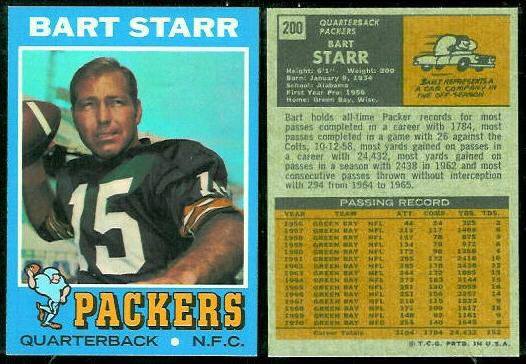Collecting Players’ Last Cards
September 23rd, 2009 | Published in General Collecting Info | 1 Comment
I read an article a long time ago–perhaps in Sports Collectors Digest?–written by someone who collected players’ last cards. A player’s last card has advantages over his rookie card, the collector said: It describes the highlights of the player’s nearly finished career, and it includes his nearly complete lifetime stats. It is likely to be from the player’s actual last year, whereas his rookie card is probably not from his rookie year at all. And, of course, it’s probably much cheaper than the player’s rookie card. Cool idea, I thought, and it stuck with me until now.
Here’s a nice example: a 1971 Topps Bart Starr card. Starr played in only four games in 1971, his last year, so the stats on the back of the card are close to his lifetime stats. The text lists the numerous Packer records he set in his career. And the price is 5-10% of what you’d pay for his rookie card.

Not all last cards are as nice as Starr’s, of course. Some don’t list all of the player’s stats, just his previous year and lifetime stats. Some, like John Unitas’s 1974 Topps card, show the player with an unfamiliar team. And some, like Joe Namath’s 1973 Topps card, are from well before the player’s last year. (Namath played until 1977.) But you can have all of these problems with rookie cards, as well.
All this considered, I still think it’s a cool idea.
- Buy Bart Starr cards from: Nearmint’s Cards, eBay

September 23rd, 2009 at 6:12 PM (#)
I’ve considered collecting second year cards of established stars. That way, they’ll have the rookie year stats. And the players look young and gawky.